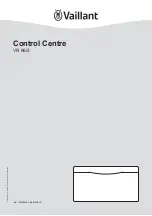
4
Installation instructions 0020140122_04
a
a
2
Safety
All electrical work performed on the equipment must be car-
ried out by a qualified engineer or Vaillant Group Service
engineer.
This equipment must only be installed by a qualified engi-
neer, to ensure that the applicable regulations and rules are
adhered to.
When work on the appliance is completed, perform an oper-
ational test and check for safety in accordance with
BS EN 7671.
2.1
General safety advices
>
Before reading this chapter, also read the general safety
advice of the operating instructions.
2.1.1 Danger to life by electric shock
Touching live connections can cause serious personal
injury.
>
Before carrying out any work on the product, switch off
the power supply.
>
Secure the power supply against being switched on
again.
2.1.2 Danger to life by escaping gas
Incorrect installation can cause leakages and explosion.
>
Make sure there are no stresses in the gas line.
>
Correctly position the seals.
>
Observe the legal directives and the local regulations for
gas supply companies.
2.1.3 Danger to life by escaping flue gases due
to unlocked openings
Flue gases can escape through openings in the flue pipe.
Inspection chambers in the flue gas pipe can be opened.
>
Open inspection chambers only if you are a competent
person.
Close all inspection chambers before start-up.
2.1.4 Danger to life due to missing or not
properly working safety devices
Missing safety devices can cause life-threatening scalding
and other injuries, for example by burst pipes.
The information contained in this document do not show all
schemes required for a professional installation of safety
devices.
>
Install the necessary safety devices in the system.
>
Inform the user about the function and location of safety
devices.
>
Observe the relevant national and international laws,
standards and guidelines.
>
The appliance is not to be used by persons (including
children) with reduced physical, sensory or mental capa-
bilities, or lack of experience and knowledge, unless they
have been given supervision or instruction.
>
Children being supervised not to play with the appliance.
2.1.5 Danger of scalding due to the hot water!
>
There is a danger of scalding at the hot water draw-off
points if the hot water temperatures are higher than
60°C. Young children and elderly persons are particularly
at risk, even at lower temperatures.
>
Select the temperature so that nobody is at risk.
>
Explain to the user how to select the best temperature
taking into account the risk of scalding and the risk of
legionella.
2.1.6 Danger due to improper use
Nonprofessional work on the product can cause damage to
the installation and as a consequence even personal injury.
>
Only work on the product if you are a competent person.
2.1.7 Risk of material damage by additives in the
heating water
Frost and corrosion protection agents can cause changes
to seals, noise during heating mode and may lead to other
consequential damage.
>
Do not use any unsuitable frost or corrosion protection
agents.
2.1.8 Risk of material damage caused by
unsuitable tools
The use of unsuitable tools or improper use thereof may
cause damage, such as gas or water leaks.
>
When tightening or loosening threaded connections,
always use suitable opened spanners, but do not use
pipe wrenches, extensions, etc.
2.1.9 Risk of structural damages by escaping
water
Incorrect installation can cause leakages.
>
Make sure there are no stresses in the hydraulic lines.
>
Correctly position the seals.
2.2
Intended use
The product is a state-of-the-art product which has been
constructed in accordance with recognised safety regula-
tions. Nevertheless, there is still a risk of injury or death to
the user or others or of damage to the product and other
property in the event of improper use or use for which it is
not intended.
The product is intended as a heating appliance for sealed
central heating installations (heating / cooling and hot
water) to consume a minimum of energy to optimize the
energy bill.
Intended use includes the following:
– observing the included operating, installation and mainte-
nance instructions for this product and any other parts
and components of the system
– installing and fitting the product in accordance with the
product and system approval
– complying with all of the inspection and maintenance
conditions listed in the instructions.



















